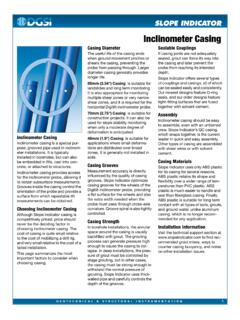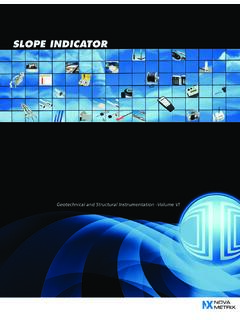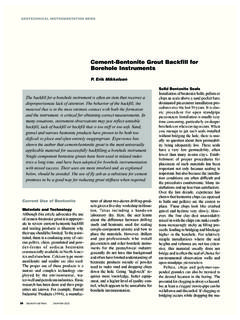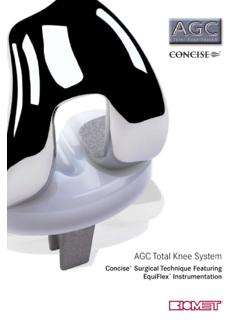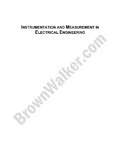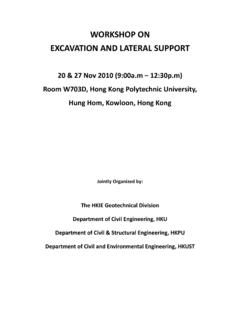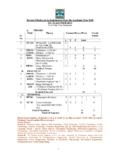Transcription of Guide to Geotechnical Instrumentation - durhamgeo.com
1 Copyright 2004 Durham Geo Slope Indicator. All Rights equipment should be installed, maintained, and operated by technically qualified personnel. Any errors or omissions in data, or the interpretation of data, are not the responsibility of Slope Indicator Company. The information herein is subject to change without document contains information that is proprietary to Slope Indicator company and is subject to return upon request. It is transmitted for the sole purpose of aiding the transaction of business between Slope Indi-cator Company and the recipient. All information, data, designs, and drawings contained herein are propri-etary to and the property of Durham Geo Slope Indicator, and may not be reproduced or copied in any form, by photocopy or any other means, including disclosure to outside parties, directly or indirectly, without per-mission in writing from Durham Geo Slope INDICATOR12123 Harbour Reach DriveMukilteo, Washington, USA, 98275 Tel: 425-493-6200 Fax: 425-493-6250E-mail: toGeotechnicalInstrumentationGuide to Geotechnical Instruments, 2004/11/24 ContentsReasons for Instrumentation .
2 1 Choosing Instrumentation .. 2 Applications and Instruments .. 4 Monitoring Pore-Water Pressure .. 5 Monitoring Lateral Deformation .. 14 Monitoring Vertical Deformation .. 20 Installing Piezometers.. 32 Installing Inclinometer Casing .. 37 Installing Settlement Cells.. 42 Installing Settlement Points .. 43 Installing Sondex .. 44 Installing Magnet Extensometers .. 46 Installing Rod Extensometers.. 48 Guide to Geotechnical Instruments, 2004/11/241 Reasons for Installing InstrumentationIntroductionGeotechnical Instrumentation provides data that helps engineers in every stage of a project. Here are the main reasons that Instrumentation is used:Site InvestigationsInstruments are used to characterize initial site conditions. Common parameters of interest in a site investigation are pore-water pressure, per-meability of the soil, and slope VerificationInstruments are used to verify design assumptions and to check that perfor-mance is as predicted.
3 Instrument data from the initial phase of a project may reveal the need (or the opportunity) to modify the design in later phases. Construction ControlInstruments are used to monitor the effects of construction. Instrument data can help the engineer determine how fast construction can proceed without the risk of failure. Quality ControlInstrumentation can be used both to enforce the quality of workmanship on a project and to document that work was done to specifications. SafetyInstruments can provide early warning of impending failures, allowing time for safe evacuation of the area and time to implement remedial action. Safety monitoring requires quick retrieval, processing, and presentation of data, so that decisions can be made ProtectionInstrument data can provide evidence for a legal defense of designers and contractors should owners of adjacent properties claim that construction has caused damage.
4 PerformanceInstruments are used to monitor the in-service performance of a structure. For example, monitoring parameters such as leakage, pore-water pressure, and deformation can provide an indication of the performance of a dam. Monitoring loads on tiebacks or rock bolts and movements within a slope can provide an indication of the performance of a drainage system installed in a stabilized to Geotechnical Instruments, 2004/11/242 Choosing InstrumentationCritical ParametersEach project presents a unique set of critical parameters. The designer must identify those parameters and then select instruments to measure them. What information is required for the initial design? What information is required for evaluating performance during and after construction? When the parameters are identified, the specification for instruments should include the required range, resolution, and precision of measurements.
5 See instrument performance specifications behavior of a soil or rock mass typically involves not one, but many parameters. In some cases, it may be sufficient to monitor only one param-eter, but when the problem is more complex, it is useful to measure a num-ber of parameters and to look for correlation between the measurements. Thus it is common practice to choose instruments that provide comple-mentary measurements. For example, inclinometer data indicating increased rate of movement may be correlated with piezometer data that shows increased pore pressures. The load on a strut, calculated from strain gauge data, should correlate with convergence data provided by inclinometer behind a retaining structure. Ground ConditionsGround conditions sometimes affect the choice of instrument. For example, a standpipe piezometer is a reliable indicator of pore-water pressure in soil with high permeability, but is much less reliable in soil with low permeabil-ity.
6 A large volume of water must flow into the standpipe to indicate even a small change in pore-water pressure. In soils with low permeability, the flow of water into and out of the standpipe is too slow to provide a timely indica-tion of pore-water pressure. A better choice in this case would be a dia-phragm-type piezometer, which offers faster response since it is sensitive to much smaller changes in water and humidity also affect instrument choice. Instruments such as hydraulic piezometers and liquid settlement gauges have limited use in freezing weather. In tropical heat and humidity, simple mechanical devices may be more reliable than electrical instruments. Personnel and Resourcesat the SiteConsider the personnel and resources at the site when choosing instru-ments. Do technicians have the skills required to install and read a particu-lar type of instrument?
7 Are adequate support facilities available for maintenance and calibration of the instrument? Guide to Geotechnical Instruments, 2004/11/243 Data AcquisitionAn automatic data acquisition system may be required when: There is a need for real-time monitoring and automatic alarms; Sensors are located at a remote site or in a location that prevents easy access; There are too many sensors for timely manual readings; Qualified technicians are not available. If a data acquisition system is required, the choice of instruments should be narrowed to those that can be connected to the system easily and inexpen-sively. Instrument LifeAre readings needed only during construction or will they be needed for years afterwards? Instruments, signal cables, and protective measures should be selected QualityThe difference in cost between a high-quality instrument and a lesser-qual-ity instrument is generally insignificant when compared to the total cost of installing and monitoring an instrument.
8 For example, the cost of drilling and backfilling a borehole is typically 10 to 20 times greater than the cost of the piezometer that goes in it. It is false economy to install a cheaper, less reliable performance is specified by range, resolution, accuracy, and precision. The economical designer will specify minimum performance requirements, since the cost of an instrument increases with resolution, accuracy, and precision. Range is defined by the highest and lowest readings the instrument is expected to produce. The designer typically specifies the highest values required. Resolution is the smallest change that can be displayed on a readout device. Resolution typically decreases as range increases. Sometimes the term "accuracy" is mistakenly substituted for resolution. Resolution is usually many times better than accuracy and is never expressed as a plus/minus value.
9 Accuracy is the degree to which readings match an absolute value. Accuracy is expressed as a value, such as , 1% of reading, or 1% of full scale. Precision or repeatability is often more important than accuracy, since what is usually of interest is a change rather than an absolute value. Every time a reading is repeated, the value returned by the instrument is slightly differ-ent. Precision is expressed as a value representing how close repeated readings approach a mean reading. Guide to Geotechnical Instruments, 2004/11/244 Applications and InstrumentsIntroductionThe tables below provide a general match between monitoring needs and Water PressureReason for MonitoringInstruments Used Determine safe rates of fill. VW Piezometer Pneumatic Piezometer Standpipe Piezometer Predict slope stability. Design and build for lateral earth pressures.
10 Design and build for uplift pressures. Monitor the effectiveness of drainage DeformationReason for MonitoringInstruments Used Evaluate the stability of slopes and embankments. Inclinometer Rod Extensometer Determine the need and timing forcorrective measures. Verify the performance and safetyof structures such as retaining wallsand DeformationReason for MonitoringInstruments Used Verify that soil consolidation is proceeding as predicted. Settlement Cells Magnet Extensometer Sondex Settlement Point Rod Extensometer Horizontal Inclinometer Predict and adjust the finalgrade of an embankment Verify the performance of engineered foundations. Determine the need and timingfor corrective to Geotechnical Instruments, 2004/11/245 Monitoring Pore-Water PressurePore-Water PressurePore-water measurements help engineers to: Establish initial site conditions.


